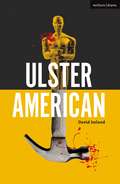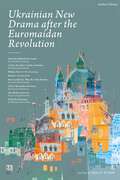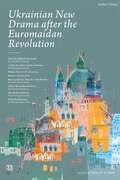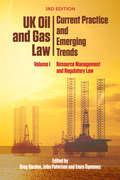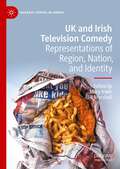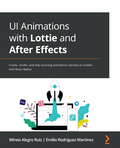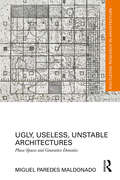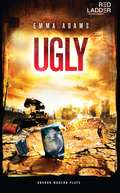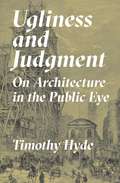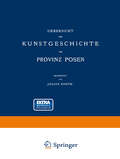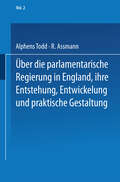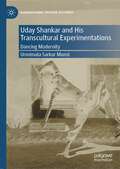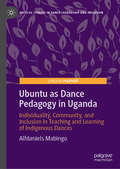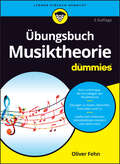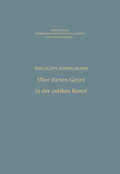- Table View
- List View
Ulster American (Modern Plays)
by David IrelandWould you mind if I asked you a troubling question?Jay is the Oscar-winning actor taking the lead in a new play that connects with his Irish roots. Leigh is the ambitious director who will do anything to get noticed. Ruth is the Northern Irish playwright whose voice must be heard.The stage is set for great success, but when the three meet to discuss the play's challenges and provocations, a line is crossed and the heated discussion quickly escalates to a violent climax. Exploring consent, abuses of power and the confusions of cultural identity, Ulster American is confrontational, brutally funny and not for the faint of heart. David Ireland's recent plays include Cyprus Avenue which won the James Tait Black Award 2017 and Best Play at the Irish Times Theatre Awards 2017. This edition is published to coincide with the world premiere at the Traverse Theatre, Edinburgh, in summer 2018.
Ukrainian New Drama after the Euromaidan Revolution: Take the Rubbish Out, Sasha; A Time Traveller's Guide to Donbas; Pilates Time; Bomb; House of Ghosts. Why. We. Fled. Donbas; I Don't Remember the Name; The Mother by Gorky; Tolyk the Diaryman
by Natalka Vorozhbyt Anastasiia Kosodii Natalia Blok Andrii Bondarenko Maksym Kurochkin Kateryna Penkova Olha MatsiupaUkraine's remarkable aptitude for resilience and grassroots activism, as witnessed since February 2022, is closely connected to a process that began with the Euromaidan Revolution in 2013-14, when over two million Ukrainians took to the streets in defense of democracy and human rights. In the months directly following the Revolution, Russia illegally occupied Ukraine's Crimean Peninsula, and began funneling both arms and troops into the eastern region of Donbas to fuel a conflict between the Ukrainian army and a small group of radical separatists. Since that time, Ukrainians have been working diligently to build the society in which they have wanted to live, all while fighting Russia and its proxies in Europe's forgotten war. Ukrainian New Drama After the Euromaidan Revolution brings together key works from the country's impressively generative post-Revolutionary period, many of them published here in English for the first time. As well as established voices from the European theatre repertoire such as Natalka Vorozhbyt and Maksym Kurochkin, this collection also features iconic plays from Ukraine's post-Maidan generation of playwrights Natalka Blok, Andrii Bondarenko, Anastsiia Kosodii, Lena Lagushonkova, Olha Matsiupa, and Kateryna Penkova. Considered together, these plays reflect the diversity of voices in Ukraine as a country seeking to comprehend both the personal and political consequences of the Revolution, the war, and all that has come since. A key element to the remarkable culture of defiance and resistance that Ukrainians created in these years has been new approaches to arts activism, particularly in the performing arts. In the eight years between Euromaidan and the full-scale invasion, Ukraine witnessed an incredible boom in socially engaged performance practice. Playwriting in particular has become an essential genre through which artists have sought to bear witness to the repercussions of the war and to create spaces for the reclaiming of historical and cultural narratives; Ukrainian New Drama After the Euromaidan Revolution captures this spirit and published this necessary and vital work in English for the very first time.
Ukrainian New Drama after the Euromaidan Revolution: Take the Rubbish Out, Sasha; A Time Traveller's Guide to Donbas; Pilates Time; Bomb; House of Ghosts. Why. We. Fled. Donbas; I Don't Remember the Name; The Mother by Gorky; Tolyk the Diaryman
by Natalka Vorozhbyt Anastasiia Kosodii Natalia Blok Andrii Bondarenko Maksym Kurochkin Kateryna Penkova Olha MatsiupaUkraine's remarkable aptitude for resilience and grassroots activism, as witnessed since February 2022, is closely connected to a process that began with the Euromaidan Revolution in 2013-14, when over two million Ukrainians took to the streets in defense of democracy and human rights. In the months directly following the Revolution, Russia illegally occupied Ukraine's Crimean Peninsula, and began funneling both arms and troops into the eastern region of Donbas to fuel a conflict between the Ukrainian army and a small group of radical separatists. Since that time, Ukrainians have been working diligently to build the society in which they have wanted to live, all while fighting Russia and its proxies in Europe's forgotten war. Ukrainian New Drama After the Euromaidan Revolution brings together key works from the country's impressively generative post-Revolutionary period, many of them published here in English for the first time. As well as established voices from the European theatre repertoire such as Natalka Vorozhbyt and Maksym Kurochkin, this collection also features iconic plays from Ukraine's post-Maidan generation of playwrights Natalka Blok, Andrii Bondarenko, Anastsiia Kosodii, Lena Lagushonkova, Olha Matsiupa, and Kateryna Penkova. Considered together, these plays reflect the diversity of voices in Ukraine as a country seeking to comprehend both the personal and political consequences of the Revolution, the war, and all that has come since. A key element to the remarkable culture of defiance and resistance that Ukrainians created in these years has been new approaches to arts activism, particularly in the performing arts. In the eight years between Euromaidan and the full-scale invasion, Ukraine witnessed an incredible boom in socially engaged performance practice. Playwriting in particular has become an essential genre through which artists have sought to bear witness to the repercussions of the war and to create spaces for the reclaiming of historical and cultural narratives; Ukrainian New Drama After the Euromaidan Revolution captures this spirit and published this necessary and vital work in English for the very first time.
UK Oil and Gas Law: Volume I: Resource Management and Regulatory Law
by Greg Gordon John PatersonA new critical and theoretical approach to a neglected aspect of Pedro Almodóvar’s cinema
UK and Irish Television Comedy: Representations of Region, Nation, and Identity (Palgrave Studies in Comedy)
by Mary Irwin Jill MarshallThis book looks at television comedy, drawn from across the UK and Ireland, and ranging chronologically from the 1980s to the 2020s. It explores depictions of distinctive geographical, historical and cultural communities presented from the insiders’ perspective, simultaneously interrogating the particularity of the lived experience of time, and place, embedded within the wide variety of depictions of contrasting lives, experiences and sensibilities, which the collected individual chapters offer. Comedies considered include Victoria Wood’s work on ‘the north’, Ireland’s Father Ted and Derry Girls, Michaela Coel’s east London set Chewing Gum, and Wales’ Gavin and Stacey. There are chapters on Scottish sketch and animation comedy, and on series set in the Midlands, the North East, the South West and London’s home counties. The book offers thoughtful reflection on funny and engaging representations of the diverse, fragmented complexity of UK and Irish identity explored through the intersections of class, ethnicity and gender.
Ui Animations With Lottie And After Effects: Create, Render, And Ship Stunning After Effects Animations Natively On Mobile With React Native
by Emilio Rodriguez Martinez Mireia Alegre RuizCreate, render, and ship stunning animations natively on mobile with React Native
Ugly, Useless, Unstable Architectures: Phase Spaces and Generative Domains (Routledge Research in Architecture)
by Miguel Paredes MaldonadoUgly, Useless, Unstable Architectures traces productive intersections between architecture and the discourses of Post-Structuralism and New Materialism. It investigates how their unique ‘ontological regimes’ can be mobilised to supersede the classical framework that still informs both the production and the evaluation of architecture. Throughout its three main chapters, this enquiry challenges one of the most prevalent tropes of architectural assessment: Beauty, Utility and Stability. Author Miguel Paredes Maldonado critically unpacks the spatial and operational qualities of these three idealised concepts, before setting out an alternative framework of spatial practice that draws from Gilles Deleuze’s post-structuralist take on the production of the real and Manuel DeLanda’s model-based branch of New Materialism. This book reads and situates a series of spatial works through the lens of this critical methodology to contest the conceptual aspects traditionally underpinning architectural ‘value’. It posits that architecture can operate as a continuous, generative spectrum encompassing a broad range of potential configurations. Written for academics and students in architectural theory, design and contemporary philosophical thought alike, this book should appeal to a wide audience.
Ugly, Useless, Unstable Architectures: Phase Spaces and Generative Domains (Routledge Research in Architecture)
by Miguel Paredes MaldonadoUgly, Useless, Unstable Architectures traces productive intersections between architecture and the discourses of Post-Structuralism and New Materialism. It investigates how their unique ‘ontological regimes’ can be mobilised to supersede the classical framework that still informs both the production and the evaluation of architecture. Throughout its three main chapters, this enquiry challenges one of the most prevalent tropes of architectural assessment: Beauty, Utility and Stability. Author Miguel Paredes Maldonado critically unpacks the spatial and operational qualities of these three idealised concepts, before setting out an alternative framework of spatial practice that draws from Gilles Deleuze’s post-structuralist take on the production of the real and Manuel DeLanda’s model-based branch of New Materialism. This book reads and situates a series of spatial works through the lens of this critical methodology to contest the conceptual aspects traditionally underpinning architectural ‘value’. It posits that architecture can operate as a continuous, generative spectrum encompassing a broad range of potential configurations. Written for academics and students in architectural theory, design and contemporary philosophical thought alike, this book should appeal to a wide audience.
Ugly (Oberon Modern Plays)
by Emma AdamsIn a world ever more focused upon global warming, climate change and the increased scarcity of resources Ugly is a dark comedy set in a future where food and water are dangerously scarce. A tale of four people who may have to kill their angels and become more like their devils if they are going to survive. Emotional, intense and visceral, this play breaks rules. It will also break your heart…Ugly is not pretty, a timely reminder of what we are doing to our planet.....reading it might just change your life.
Ugliness and Judgment: On Architecture in the Public Eye
by Timothy HydeA novel interpretation of architecture, ugliness, and the social consequences of aesthetic judgmentWhen buildings are deemed ugly, what are the consequences? In Ugliness and Judgment, Timothy Hyde considers the role of aesthetic judgment—and its concern for ugliness—in architectural debates and their resulting social effects across three centuries of British architectural history. From eighteenth-century ideas about Stonehenge to Prince Charles’s opinions about the National Gallery, Hyde uncovers a new story of aesthetic judgment, where arguments about architectural ugliness do not pertain solely to buildings or assessments of style, but intrude into other spheres of civil society.Hyde explores how accidental and willful conditions of ugliness—including the gothic revival Houses of Parliament, the brutalist concrete of the South Bank, and the historicist novelty of Number One Poultry—have been debated in parliamentary committees, courtrooms, and public inquiries. He recounts how architects such as Christopher Wren, John Soane, James Stirling, and Ludwig Mies van der Rohe have been summoned by tribunals of aesthetic judgment. With his novel scrutiny of lawsuits for libel, changing paradigms of nuisance law, and conventions of monarchical privilege, he shows how aesthetic judgments have become entangled in wider assessments of art, science, religion, political economy, and the state.Moving beyond superficialities of taste in order to see how architectural improprieties enable architecture to participate in social transformations, Ugliness and Judgment sheds new light on the role of aesthetic measurement in our world.
Ugliness and Judgment: On Architecture in the Public Eye
by Timothy HydeA novel interpretation of architecture, ugliness, and the social consequences of aesthetic judgmentWhen buildings are deemed ugly, what are the consequences? In Ugliness and Judgment, Timothy Hyde considers the role of aesthetic judgment—and its concern for ugliness—in architectural debates and their resulting social effects across three centuries of British architectural history. From eighteenth-century ideas about Stonehenge to Prince Charles’s opinions about the National Gallery, Hyde uncovers a new story of aesthetic judgment, where arguments about architectural ugliness do not pertain solely to buildings or assessments of style, but intrude into other spheres of civil society.Hyde explores how accidental and willful conditions of ugliness—including the gothic revival Houses of Parliament, the brutalist concrete of the South Bank, and the historicist novelty of Number One Poultry—have been debated in parliamentary committees, courtrooms, and public inquiries. He recounts how architects such as Christopher Wren, John Soane, James Stirling, and Ludwig Mies van der Rohe have been summoned by tribunals of aesthetic judgment. With his novel scrutiny of lawsuits for libel, changing paradigms of nuisance law, and conventions of monarchical privilege, he shows how aesthetic judgments have become entangled in wider assessments of art, science, religion, political economy, and the state.Moving beyond superficialities of taste in order to see how architectural improprieties enable architecture to participate in social transformations, Ugliness and Judgment sheds new light on the role of aesthetic measurement in our world.
Ugliness and Judgment: On Architecture in the Public Eye
by Timothy HydeA novel interpretation of architecture, ugliness, and the social consequences of aesthetic judgmentWhen buildings are deemed ugly, what are the consequences? In Ugliness and Judgment, Timothy Hyde considers the role of aesthetic judgment—and its concern for ugliness—in architectural debates and their resulting social effects across three centuries of British architectural history. From eighteenth-century ideas about Stonehenge to Prince Charles’s opinions about the National Gallery, Hyde uncovers a new story of aesthetic judgment, where arguments about architectural ugliness do not pertain solely to buildings or assessments of style, but intrude into other spheres of civil society.Hyde explores how accidental and willful conditions of ugliness—including the gothic revival Houses of Parliament, the brutalist concrete of the South Bank, and the historicist novelty of Number One Poultry—have been debated in parliamentary committees, courtrooms, and public inquiries. He recounts how architects such as Christopher Wren, John Soane, James Stirling, and Ludwig Mies van der Rohe have been summoned by tribunals of aesthetic judgment. With his novel scrutiny of lawsuits for libel, changing paradigms of nuisance law, and conventions of monarchical privilege, he shows how aesthetic judgments have become entangled in wider assessments of art, science, religion, political economy, and the state.Moving beyond superficialities of taste in order to see how architectural improprieties enable architecture to participate in social transformations, Ugliness and Judgment sheds new light on the role of aesthetic measurement in our world.
Ugliness and Judgment: On Architecture in the Public Eye
by Timothy HydeA novel interpretation of architecture, ugliness, and the social consequences of aesthetic judgmentWhen buildings are deemed ugly, what are the consequences? In Ugliness and Judgment, Timothy Hyde considers the role of aesthetic judgment—and its concern for ugliness—in architectural debates and their resulting social effects across three centuries of British architectural history. From eighteenth-century ideas about Stonehenge to Prince Charles’s opinions about the National Gallery, Hyde uncovers a new story of aesthetic judgment, where arguments about architectural ugliness do not pertain solely to buildings or assessments of style, but intrude into other spheres of civil society.Hyde explores how accidental and willful conditions of ugliness—including the gothic revival Houses of Parliament, the brutalist concrete of the South Bank, and the historicist novelty of Number One Poultry—have been debated in parliamentary committees, courtrooms, and public inquiries. He recounts how architects such as Christopher Wren, John Soane, James Stirling, and Ludwig Mies van der Rohe have been summoned by tribunals of aesthetic judgment. With his novel scrutiny of lawsuits for libel, changing paradigms of nuisance law, and conventions of monarchical privilege, he shows how aesthetic judgments have become entangled in wider assessments of art, science, religion, political economy, and the state.Moving beyond superficialities of taste in order to see how architectural improprieties enable architecture to participate in social transformations, Ugliness and Judgment sheds new light on the role of aesthetic measurement in our world.
UFO Religion: Inside Flying Saucer Cults and Culture
by Gregory L. ReeceLines laid across the plain near the Peruvian site of Nazca have been explained as ancient roads or features of a long-forgotten religious calendar. So why did Erich von Daniken interpret these markings as the contours of a huge galactic spaceport? In his assessment of the uncanny and frequently eerie world of UFO-logy, Gregory L Reece travels deep into a mindset which believes that the gods of mythology were really visitors from the stars. Venturing into the Mojave Desert to watch the night skies for flying saucers; exploring Nevada's top-secret installation 'Area 51'; and visiting Roswell, famous site of a supposed saucer crash in 1947, the author's quest for the truth brings him more than he bargained for. He has his atomic structure recharged in a machine supposedly designed by extraterrestrial technology, encounters a whole galaxy of alien life-forms, and meets those who claim themselves to have been abducted by UFOs. Along the way he tries to make sense both of the sinister 'Men in Black' and of lethal 'Tall Whites', deadly aliens who liquidate human beings without mercy. What is it about flying saucer culture that speaks to people with an apparently religious intensity and fervour? For those looking for the answers, UFO Religion is the definitive guide and handbook to one of the most extraordinary and compelling cults of our times.
Ueber die parlamentarische Regierung in England, ihre Entstehung, Entwickelung und praktische Gestaltung: Zweiter Band
by NA Todd R. AssmannUday Shankar and His Transcultural Experimentations: Dancing Modernity (Transnational Theatre Histories)
by Urmimala Sarkar MunsiThis monograph presents a specific experience of modernity within the context of Indian dance by looking at the transcultural journey of Indian dancer / choreographer Uday Shankar (1900b – 1977d). His popularity in Europe and America as an Oriental male dancer in the first half of the 20th century, and his worldwide recognition as the Ambassador of Indian culture, are brought into a historiographical perspective within the cultural and social reforms of early twentieth century India. By exploring his artistic journey beyond India in the period between the two world wars, and his experience of dance making, presentational technique and representation of India through various phases of his life, a path is forged to understanding the emergence of modernity in Indian dance.
Ubuntu as Dance Pedagogy in Uganda: Individuality, Community, and Inclusion in Teaching and Learning of Indigenous Dances (Critical Studies in Dance Leadership and Inclusion)
by Alfdaniels MabingoThis book locates the philosophy of Ubuntu as the undergirding framework for indigenous dance pedagogies in local communities in Uganda. Through critical examination of the reflections and practices of selected local dance teachers, the volume reveals how issues of inclusion, belonging, and agency are negotiated through a creatively complex interplay between individuality and communality. The analysis frames pedagogies as sites where reflective thought and kinaesthetic practice converge to facilitate ever-evolving individual imagination and community innovations.
Übungsbuch Musiktheorie für Dummies (Für Dummies)
by Oliver FehnWenn der Stoff sitzen soll, muss man die Theorie auch mal praktisch angehen. Denn auch bei der Musiktheorie hilft vor allem Üben, Üben, Üben. Dieses Buch enthält abwechslungsreiche Übungen, kurzweilige Multiple-Choice-Tests, hilfreiche Eselsbrücken und viele Tipps und Tricks, die Ihnen helfen, Ihr musiktheoretisches Wissen zur Perfektion zu bringen. Sie finden kompakte Erklärungen der wichtigsten musiktheoretischen Grundlagen und natürlich ausführliche Lösungen zu den zahlreichen Übungen. Viele der Übungen und Lösungen gibt es außerdem zum Anhören als Download. Sie erfahren Wie Sie Ihr musiktheoretisches Wissen durch Übungen zu Noten, Akkorden, Intervallen, Tonleitern, Tonarten und Co. vertiefen Wie Sie Musik notieren und spielen Wie Sie Ihr Lieblingsstück in eine andere Tonart transponieren
Ubiquitous Computing and Multimedia Applications: Second International Conference, UCMA 2011, Daejeon, Korea, April 13-15, 2011. Proceedings, Part I (Communications in Computer and Information Science #150)
by Tai-Hoon Kim Hojjat Adeli Rosslin John Robles Maricel BalitanasThis two-volume set (CCIS 150 and CCIS 151) constitutes the refereed proceedings of the Second International Conference on Ubiquitous Computing and Multimedia Applications, UCMA 2011, held in Daejeon, Korea, in April 2011. The 86 revised full papers presented were carefully reviewed and selected from 570 submissions. Focusing on various aspects of advances in multimedia applications and ubiquitous computing with computational sciences, mathematics and information technology the papers present current research in the area of multimedia and ubiquitous environment including models and systems, new directions, novel applications associated with the utilization, and acceptance of ubiquitous computing devices and systems.
Ubiquitous Computing and Multimedia Applications: Second International Conference, UCMA 2011, Daejeon, Korea, April 13-15, 2011. Proceedings, Part II (Communications in Computer and Information Science #151)
by Tai-Hoon Kim Hojjat Adeli Rosslin John Robles Maricel BalitanasThis two-volume set (CCIS 150 and CCIS 151) constitutes the refereed proceedings of the Second International Conference on Ubiquitous Computing and Multimedia Applications, UCMA 2011, held in Daejeon, Korea, in April 2011. The 86 revised full papers presented were carefully reviewed and selected from 570 submissions. Focusing on various aspects of advances in multimedia applications and ubiquitous computing with computational sciences, mathematics and information technology the papers present current research in the area of multimedia and ubiquitous environment including models and systems, new directions, novel applications associated with the utilization, and acceptance of ubiquitous computing devices and systems.
Über Projektionen: Von der Rekonstruktion zur Dekonstruktion, von der Konvention zur Alternative (Image #147)
by Julia Mia Stirnemann»Über Projektionen« gibt Einsichten in Weltkarten, ihre Darstellungsweisen und den damit verbundenen Weltanschauungen. Die Projektion wird dabei einerseits als ideelle Projektion im Sinne einer Weltanschauung dargelegt, die vorherrschende Vorstellungsbilder, Wertmaßstäbe, Ordnungsprinzipien, Denkweisen oder Erklärungsmodelle der Welt beschreibt. Andererseits wird auf die geometrische Projektion, die Weltkarten zugrunde liegt, fokussiert: Jede Weltkarte steht vor der Schwierigkeit, die Kugeloberfläche in einer zweidimensionalen Ebene darzustellen. In einer Rekonstruktion werden anhand von Weltkarten verschiedene paradigmatische Weltanschauungen aufgezeigt. In einer Dekonstruktion sind konventionelle durch alternative Weltkarten kontrastiert. Die breite Vielfalt an möglichen Weltkarten zeigt, dass Weltkarten keinen Status quo abbilden, sondern lediglich eine subjektive Interpretation der Welt zu einem bestimmten Zeitpunkt sind, die ständigen Umbrüchen unterworfen bleiben.
Über Hirten-Genre in der antiken Kunst (Abhandlungen der Rheinisch-Westfälischen Akademie der Wissenschaften #65)
by Nikolaus HimmelmannÜber Form und Struktur – Geometrie in Gestaltungsprozessen
by Cornelie LeopoldFormen und Strukturen werden als grundlegende Gestaltungsrelationen, insbesondere in Architektur und Produktdesign, untersucht. Die Autoren aus unterschiedlichen Disziplinen gehen der Frage nach, welche Rolle die Geometrie bei Formbildungsprozessen spielt. Traditionell kommt der Geometrie die Aufgabe zu, Formen erfassbar, darstellbar und umsetzbar zu machen, deren Erzeugungsregeln zu untersuchen. Die aktuellen Entwicklungen zeigen die Verwendung immer komplexerer, unregelmäßigerer und scheinbar "ungeometrischer" Formen. Neben geometrischen und topologischen Betrachtungen werden systemtheoretische Überlegungen sowie Prozesse der Morphogenese den Gestaltungen zugrunde gelegt. Die Autoren thematisieren Bezüge zwischen Form, Struktur und Materialität und wenden sich damit gegen aktuelle Tendenzen einer Beliebigkeit der Gestaltung. Ingenieurwissenschaftliche und künstlerisch-ästhetische Gestaltungsansätze finden zusammen. Die Bedeutung mathematisch-strukturellen und geometrischen Denkens in diesen komplexen Zusammenhängen werden sowohl in historischem Kontext beleuchtet als auch in computerbasierten Arbeitsprozessen in realisierten Beispielen aus der Praxis aufgezeigt.
Über die Grenzen des Bildes: Kulturelle Differenz und transkulturelle Dynamik im globalen Feld der Kunst (Image #174)
by Birgit MersmannIm globalisierten Vernetzungsraum der Kunstsphäre befinden sich bildkulturelle Grenzen zwischen nationalen und regionalen Künsten zunehmend in Auflösung. Wo lassen sich Grenzverschiebungen im globalen Feld moderner und zeitgenössischer Kunst orten? Durch welche differenziellen Sicht- und Darstellungsweisen werden Abgrenzungen markiert und Bildkulturkonflikte befördert? In welchen Kontaktzonen und unter welchen Kulturtransferbedingungen bilden sich transkulturelle Dynamiken heraus? Aus der Perspektive kulturwissenschaftlicher Bildforschung erkundet Birgit Mersmann Grenzziehungen, Grenzverhandlungen und Grenzüberschreitungen zwischen westlicher, asiatischer und arabischer Bildkunst.
